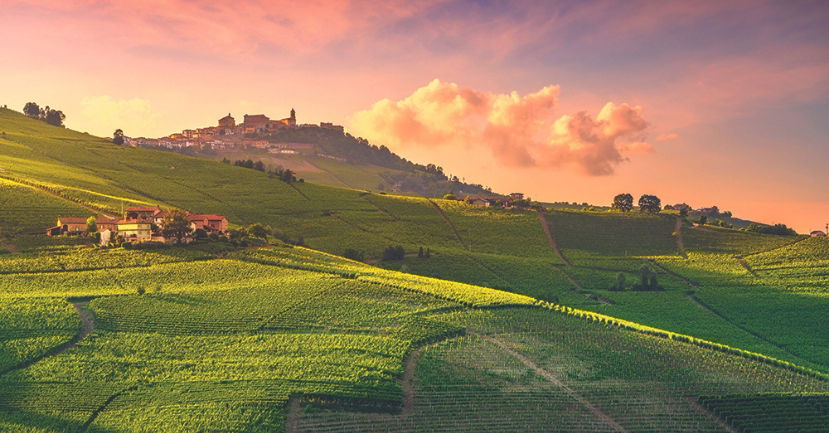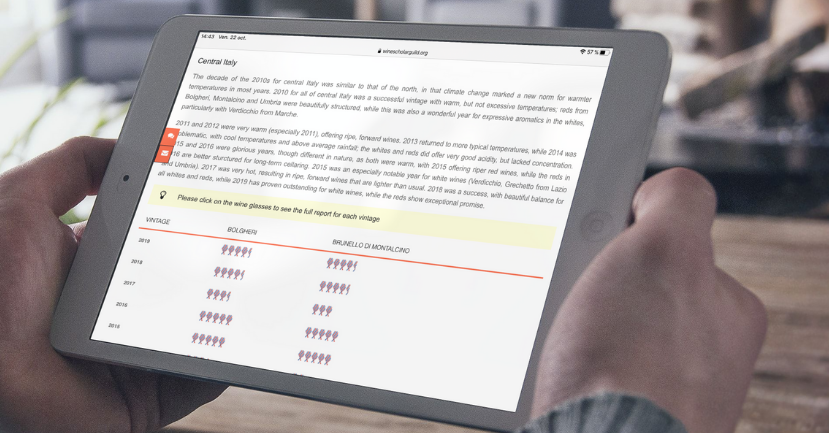BLOG
Italian Vintage Chart, from 2010 to 2020
Tom Hyland
Wine Education & Careers

Wine Scholar Guild is pleased to provide its readers with vintage and harvest reports for some of Italy’s most famous regions, from 2010 onward. We felt it was time that we expand our assessment of vintages and harvest reports outside of France and Italy was first on our list. To compile this in-depth report, we reached out to Italian wine specialist Tom Hyland.
Tom seemed like the perfect fit for this project, as he has been reporting on and promoting Italian wines for more than twenty years as a journalist, educator, and photographer. He has made more than 75 trips to wine regions throughout all of Italy from his home in Chicago. In that time, he has written for numerous publications, including Decanter, wine-searcher.com and most recently Wine Spectator. He has written two books on Italian wine: Beyond Barolo and Brunello (2013) and The Wines and Foods of Piemonte (2016). Tom has conducted seminars on Italian wine for the trade and public; over the past year, he has led more than two dozen webinars with Italian producers; among these were several for Wine Scholar Guild. He also served as US ambassador for Consorzio I Vini del Piemonte for five years. He is also an accomplished photographer, having been named Wine Photographer of the Year (Category: Places) in 2020 at the prestigious Pink Lady competition in England.
Andrea Eby, Italian Programs Director, asked Tom to provide a short blog article describing how he went about compiling this fantastic resource. We hope you enjoy the article and find the vintage charts as useful as we do. As always, we look forward to your questions and comments!
I have assembled a vintage chart covering several different Italian red wines from the years 2010-2020 for Wine Scholar Guild, focusing on Barolo/Barbaresco, Brunello di Montalcino, Amarone della Valpolicella, Taurasi and Etna rosso.
The wines are ranked from one glass (poor) to five glasses (exceptional), which is the same system employed by Andrew Jefford in his thorough French vintage chart for Wine Scholar Guild. The specific ratings were made by me based on several factors, such as tasting these wines over the past several years (primarily in their respective territories during my frequent visits, but also at home over the past 18 months due to travel restrictions), as well as interviews with and gathering data from dozens of producers. Most of them shared detailed notes on the growing seasons, harvest data and their thoughts on the quality of the wines from the past decade. I am greatly indebted to these producers across Italy for their invaluable help.
Click HERE to access our Italian Wine Vintage Chart and detailed Vintage Reports from 2010 to 2020. The Vintage Charts were last updated on August 3, 2022 to include the 2020 vintage.
Barolo / Barbaresco
Let’s examine the ranking of these vintages, going from north to south, beginning with Barolo and Barbaresco from the Langhe district in Piedmont. As anyone who has been following Barolo and Barbaresco over the past few years realizes, the decade of the 2010s has been a glorious one for local producers. Some of this has to do with the changing climate, as most years have been rather warm – with a few years bordering on hot – meaning that Nebbiolo ripens without too many difficulties.
Yet, climate change on its own cannot fully explain the consistent excellence of these wines during this past decade. Yes, Mother Nature has blessed this territory with ample sunshine, but human labor both in the vineyards and in the cellar have refined these wines. Not only are the grapes at harvest ripe, but there is more even ripening, especially compared to wines some three to four decades ago; much of this has to do with green harvest, assuring that a smaller crop in the vineyards assures riper, more concentrated grapes.
Interestingly, leaf removal, which for many years helped the Nebbiolo bunches receive more sunshine, is now practiced on a more limited basis, as the warmer temperatures can sometimes lead to over ripeness.
In the cellar, more Barolo and Barbaresco producers are practicing long macerations; 25-30 days has again become the norm (as it was 30-50 years ago), as the long chain tannins mesh to become rounder and silkier. A great example of this can be found in many examples of Barolo and Barbaresco from the outstanding 2016 vintage; while the best examples of these wines have a cellar potential of more than two decades, a great number of these wines are approachable upon release. Naturally, the wines will offer greater complexity after a few more years in the bottle, but the fact that you could drink a 2016 Barolo upon release and be charmed by its overall harmony, speaks not only to ideal ripeness, but also a philosophy by the vintners to bring about a more graceful, stately wine.
This is especially true for the 2017 vintage, the hottest growing season of the decade. In past years, one might have expected these wines upon release to display cooked fruit or a gritty finish; yet the finest 2017s are quite approachable at present, thanks to their round tannins. These are lighter wines, no doubt, so while most will not have great staying power, they will be very enjoyable over the next 5-7 years. This is much different than the last torrid growing season of 2003, when the wines were overripe and tough; based on this, it seems that excessive heat will not be a major problem for Barolo and Barbaresco producers in the future.
The exception to the warm vintages of the decade was 2014, a year that was characterized by above average rainfall as well as untimely hailstorms. But there were many examples of excellent 2014 Barolo and Barbaresco (more so in the latter territory) that while not powerful, did offer excellent structure; numerous producers told me that their 2014s reminded them of the wines their fathers and grandfathers produced 20-40 years ago.
See full Barolo/Barbaresco vintage report
Amarone
Climate change has been a mixed blessing in Valpolicella, where Amarone is produced. While warmer temperatures have resulted in riper grapes and more pronounced fruit perfumes, this has also meant today’s alcohol levels of 16% to 16.5% alcohol, sometimes resulting in powerful wines that lack proper harmony.
Also, because the grapes used to produce Amarone are picked slightly underripe - a necessity, as the grapes will increase in alcohol during the appassimento process - slightly cooler temperatures are what are preferred here; thus, the relatively cool 2010 vintage in Valpolicella remains the finest year for Amarone of the decade. These wines have exceptional harmony and will drink well for at least another 10-15 years.
Of course, if sufficient heat is not present during the growing season, problems will occur; there is no better example of this than the 2014 vintage, which several producers told me was one of the worst seasons they had ever seen; wineries that normally produced single vineyard versions or special selection Amarone did not make these wines in many instances in 2014.
Overall, quality was very good for Amarone in the decade of the 2010s, but given the climatic conditions of northern Italy, and specifically Valpolicella - hailstorms and heavy rains (which now occur more often than in the past (a direct byproduct of climate change) – Amarone displayed less consistency than other wine districts in the country.
See full Amarone vintage report
Bolgheri
Throughout the decade of the 2010s, Bolgheri producers performed with more consistent excellence than almost any other wine territory in the country. Much of this has to do with local vintners finding the best combination of varietals for their red wines, while the area’s climate clearly remains an important factor. Excessive heat is mitigated by the proximity to the sea, allowing the vines to receive sufficient sunshine without the grapes becoming overripe. The cool 2014 growing season was the least powerful vintage in Bolgheri during the decade, but this was still a successful year for Bolgheri reds, as they offer the structure for mid-term aging thanks to healthy acidity, while in years such as 2010, 2015 and 2016, the top wines have tremendous cellar potential. While this past decade has already seen some outstanding years in Bolgheri, 2018 and 2019 may prove to be the best, with the former an extremely elegant vintage, and the latter promising great freshness and classic structure.
See full Bolgheri vintage report
Brunello di Montalcino
The story of Brunello di Montalcino can be broken down into two halves of the decade. While 2010 and especially 2012 were excellent vintages, other years through 2014 were less than stellar, with this last being the least accomplished of the decade. But Brunello quality took a remarkable upswing with consecutive years in 2015 and 2016; the former is a more powerful vintage, while the latter is more classically structured one. 2017 was a very warm growing season here, and while the wines do not offer stellar aging potential, they are well balanced. 2018 looks to be a very good year, with beautifully balanced wines, while 2019 should challenge for the best vintage of the decade.
See full Brunello di Montalcino vintage report
Taurasi
Local producers can point to the fact that examples of Taurasi from the 1950s are still drinking well, but wines that have this type of staying power require several factors. One is a long, not too hot growing season, as Aglianico grapes are often harvested in November, when there are much fewer sunshine hours than in September or October. Also, given the tannins of Aglianico, proper phenolic ripeness is essential for crafting a Taurasi that will display elegance as well as aging potential. Climatic changes over the past decade have made life anything but routine for Taurasi producers; 2010, 2013, 2016 and 2019 were the finest years, resulting in wines that displayed more pronounced aromatics and healthier acidity than vintages such as 2014, 2017 or 2018.
See full Taurasi vintage report
Etna Rosso
Over the decade, the red wines of Etna have improved significantly, as producers have discovered the best sites – generally on the north slopes of Etna – in which to plant their vineyards. Precipitation is a tricky problem here; the right amount means excellent water reserves for the vines, while too much, as in 2018, can result in wines of lighter concentration and lesser complexity. The two finest vintages of Etna Rosso are 2014 and 2016, while 2019 (most of these wines will be released over the coming year) should join these other two years at the top. 2019 is particularly interesting, given the lengthy period of cold winter in the spring, followed by dramatic heat spikes throughout various periods of the summer; 2016 produced wines of outstanding concentration, while 2014 offered wines of superb complexity as well as ideal acidity. Only 2013 and 2017 were less than 4-star vintages, while 2011 and 2012 – the former more powerful, the latter offering higher acidity levels – are very impressive vintages.





